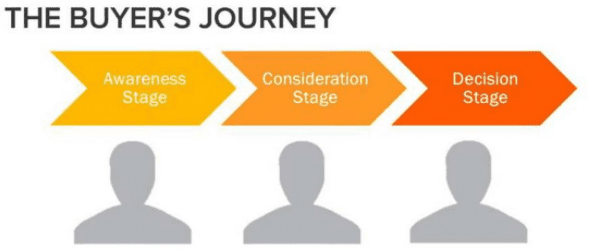How to know your audience and create the right content for them
We've all heard the phrase ‘the client is king’. In practice, this means that an important part of marketing is an exercise of empathy, which consists of finding out who our audience is, so we can give them what they want in a better way than our competition.
This simple idea should also be the center of your efforts when it comes to increasing your leads. You should adjust to them, and to their buying process. You should give your prospects the answers they are looking for, when they’re looking for them, in an appropriate way to address the subject of their interest.
The Inbound Approach
But let’s start from the beginning. You may have heard the term “inbound marketing” before. If you haven't, it mainly consists of making leads come to you, rather than you going to them. Unfortunately, that doesn’t mean it enables you to let the prospect do all the work.However, it is a great strategy to work your way into gaining leads that are interested in what you have to offer.
Inbound marketing’s key to attracting clients is quality content: knowledge and information related to what you do that your prospects find interesting or useful. They probably won’t surf the internet looking for the cool ads of your locksmith business’s new campaign, but they’ll sure want to know how can they fix their lock if their key got stuck in it and they can’t get into their house. Your path to obtain more and better leads can start from there.
Right Timing, Right Content
Since the whole point is to create content to attract your leads, it’s crucial that you consider which stage of the buyer’s journey they are on, so you can create the content they are looking for in that specific moment. The stages are three:
- Awareness: When the buyer understands there is a problem or opportunity. This leads them to search for more information about it and, hopefully, to get that information they want from you. The goal is to get the prospect’s attention in a non-invasive way.
- Consideration: Once the buyer understands the problem better, they’ll want to figure out how to tackle the issue. This is your opportunity to explain to your now receptive prospect what your business is all about, and how your product can impact their life for the better.
- Decision: Eventually, the buyer defines what to do, whether to buy or not, from you or your competition. Here you want to help your prospects make a decision, explain why your product is the best choice, the different options you provide them to pay, etc.
Great Content Formats
Different content should be created for each different stage, so the prospects can find exactly what they are looking for in that particular point of the buying process. In the case of the Consideration Stage, every format that proves useful to explain, elaborate or exemplify the solutions your product or service can deliver to the prospect can be a good option. Case studies, white papers, lists and product reviews are good choices to create content for this phase.
Also, it’s important for the content to be as visual as possible. Text-based content can be very good if you want to provide a large amount of information with low cost, but 65% of people are visual learners, so using images will make understanding much easier.
This is also a good reason to prefer visual content marketing formats. But even putting aside its didactic potential, they have a proven formula to boost impact and effectiveness. Introducing infographics in your content, if you don’t yet do it, can lead you to increase your traffic by 12 percent. And in the case of presentations, they are 43 percent more effective if they include visual aids.
The Best Content is Video
However, to really enhance the performance of your content through visual marketing content, the best thing you can do is to use video. Internet video is on the rise: by 2019, consumer internet video traffic will be 80 percent of all consumer internet traffic (in 2014 it was already 65 percent). This rise in traffic includes mobile as well, which is a growing trend itself. Also, Youtube reported that mobile video consumption rises 100 percent every year, and an important Facebook executive says that in 5 years, all content on Facebook will be video. When it comes to content and inbound marketing, video is both the present and the future.
Video content comes in many formats, some of which are better suited for the Consideration Stage. For example, Educational Videos can provide information about how to solve a problem the prospects may be having. These are good to show the way a product works. A good example of these are Moz’s Whiteboard Friday Videos, which are all about SEO-related topics:
Another good option is Testimonial Videos. They enable you to use your client’s satisfaction to establish credibility for your business, so they are an excellent choice when this is your priority. A good way to create a stronger impression with this type of video is to make as many clients as you can to share their experience with you on them, like in this video from The Blessed Bean.
If you think your company’s culture, personality and human side are strong points to make an impression, you can create a Company Culture Video and show what you do from a more sensitive perspective. In this video created by Wistia, Zappos’s staff explain how being happy and having fun at work is a major priority to them.
However, the most adjusted and natural choice for this particular stage of the buyer’s journey is an Explainer Video. This is the case, basically because it’s perceived to do exactly what you are supposed to do in this phase: explain what the company and the product can do and how they can meet the prospect’s needs. It is supposed to explain your product or service, not a subject in general, as Educational Videos do. And as good as Company Culture Videos and Testimonial Videos can be to stress certain aspects of your company, like its personality or reliability, when the buyer is wondering what your company is about and ‘what-is-in-for-me-if-I-choose-you’, nothing cuts to the chase better than an Explainer Video. For example, this Explainer Video, created by Yum Yum Videos for Walmart, explains the seamless buying experience that the brand’s clients can enjoy, being able to find information about every product from their smartphones, as well as their personal computers and inside the store.
The Consideration Stage is all about making the best possible case about what you have to offer, at the right time, with the right formats and media. Get this right and you shall gain more and better leads, which will result in more and better clients, which is what your business (and every other) is all about.
source http://www.smartinsights.com/digital-marketing-strategy/inbound-marketing-strategy/convert-interest-leads/


 Thanks to Silvio Acevedofor sharing their advice and opinions in this post. Silvio Acevedo is a digital content professional, passionate for everything related to social communications. You can follow him on
Thanks to Silvio Acevedofor sharing their advice and opinions in this post. Silvio Acevedo is a digital content professional, passionate for everything related to social communications. You can follow him on
No comments:
Post a Comment